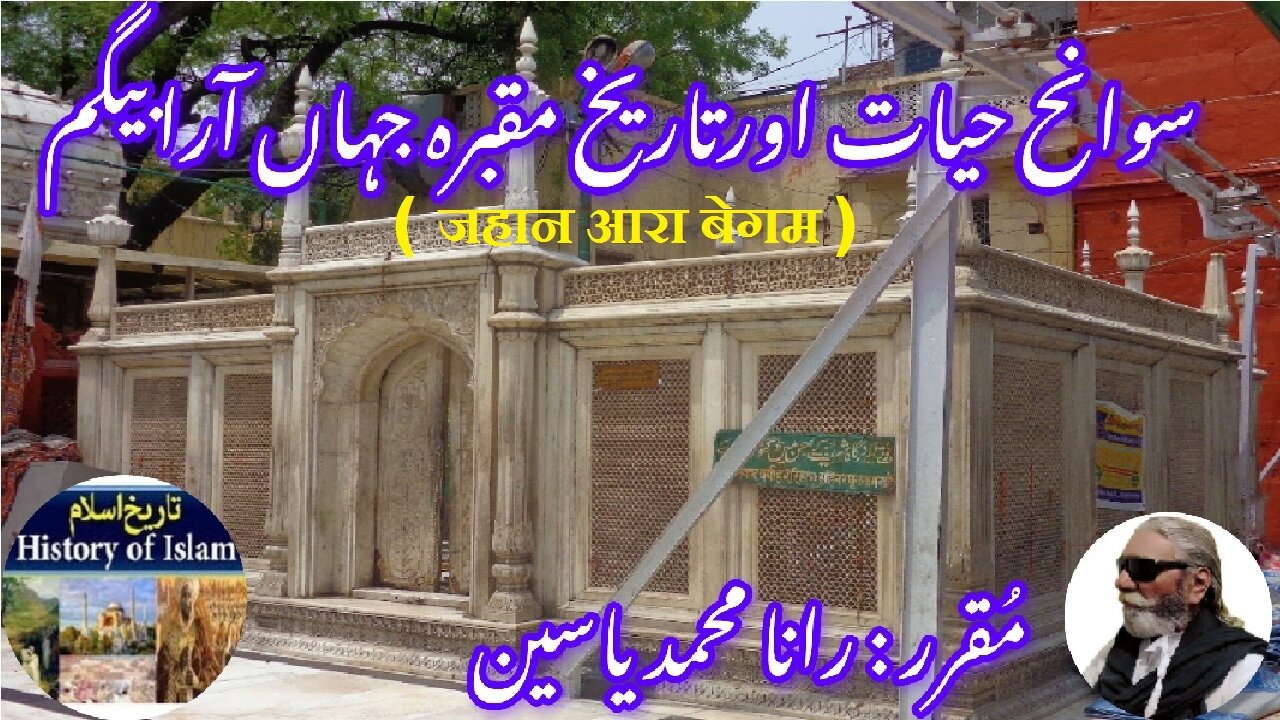Premium Only Content

Jahan Ara Begum जहान आरा बेगम جہاں آرا بیگم کی سوانح حیات اور ان کے مزار کی تاریخ
@islamichistory813 #sufisaint #culturalheritage #biography #jahanarabegum #islamicmysticism #islamicphilosophy #shrine #historicalfigures
Biography of Jahan Ara Begum and the history of his shrine
Dekhti Aankhooon aur sountay kaanoon ko Asslamoalaikum, sisters, brothers friends and elders, in informative series videos of Islamic ascolars, sufisaints, cultural heritages, islamic philosophys, islamic mysticisms and historical figures. today we are describing biography of Jahanara Begum and the history of his shrine.
Jahanara Begum was born on 23 March 1614, in Ajmer, India, she was a princess of the Mughal Empire. She was the second and the eldest surviving child of Mughal Emperor Shah Jahan and Mumtaz Mahal.
After Mumtaz Mahal's untimely death in 1631, the 17-year-old Jahanara was entrusted with the charge of the royal seal and conferred the title of Padshah Begum (First lady) of the Mughal Empire, even though her father had three surviving wives. She was Shah Jahan's favorite daughter and she wielded major political influence during her father's reign, and has been described as "the most powerful woman in the empire" at the time.
Jahanara was an ardent partisan of her brother, Dara Shikoh, and supported him as her father's chosen successor. During the war of succession which took place after Shah Jahan's illness in 1657, Jahanara sided with the heir-apparent Dara and joined her father in Agra Fort, where he had been placed under house arrest by Aurangzeb. When Aurangzeb ascended to the throne, Jahanara was replaced by her younger sister, Roshanara as Padshah Begum. A devoted daughter, she took care of Shah Jahan until his death in 1666. Later, Jahanara reconciled with Aurangzeb who gave her the title 'Empress of Princesses' and replaced her younger sister, Princess Roshanara Begum, as the First Lady. Jahanara died during Aurangzeb's reign. She is known for her written works as well, which continues to be a primary way in which her presence in Sufism survives into today. She is well known for a biography of Sheikh Mu’in ad’-Din Chishti, ‘Munis al arwah’ whom she believed to have been the highest of the Sufi saints in India and her spiritual master, despite having lived four centuries before her.
Jahanara's early education was entrusted to Sati al-Nisa Khanam, the sister to Jahangir's poet laureate, Talib Amuli. Sati al-Nisa was known for her knowledge of the Qur'an and Persian literature, as well as for her knowledge of etiquette, housekeeping, and medicine. She also served as principal lady-in-waiting to her mother, Mumtaz Mahal.
Many of the women in the imperial household were accomplished at reading, writing poetry and painting. They also played chess, polo and hunted outdoors. The women had access to the late Emperor Akbar's library, full of books on world religions, and Persian, Turkish and Indian literature. Jahanara was no exception.
From a carefree girl, she was pushed into government politics, overseeing domestic and international trade, and even mediating courtiers and foreigners to communicate with the emperor, and was involved in the tasks of resolving family disputes. Upon the death of Mumtaz Mahal in 1631, Jahanara, aged 17, took the place of her mother as First Lady of the Empire, despite her father having three other wives. In addition to caring for her younger brothers and sisters, she was also a good caretaker of her father.
One of her tasks after the death of her mother was to oversee, with the help of Sati al-Nisa, the betrothal and wedding of her brother, Dara Shikoh to Nadira Banu Begum, which was originally planned by Mumtaz Mahal, but postponed by her death.
Her father frequently took her advice and entrusted her with the charge of the Imperial Seal. Having the right to issue farmans [clarification needed] and nishans [clarification needed], she was given the greatest and highest rank in the harem. She also attended councils and discussed important aspects of state and governance from behind her curtained seat. The state nobles and kings or foreign ambassadors, whether commercial or political, sought her intervention before the emperor. Her word became so powerful that it was said that it could change the fortunes of people. As French traveller and physician François Bernier writes in his memoirs,Travels in the Mogul Empire,
"Shah Jahan reposed unbounded confidence in his favourite child; she watched over his safety, and so cautiously observant, that no dish was permitted to appear upon the royal table which had not been prepared under her superintendence."
In 1644, when Aurangzeb angered his father, the Badshah, Jahanara interceded on her brother's behalf and convinced Shah Jahan to pardon him and restore his rank.[8] Shah Jahan's fondness for his daughter was reflected in the multiple titles that he bestowed upon her, which included: Sahibat al-Zamani (Lady of the Age), Padishah Begum (Lady Emperor), and Begum Sahib (Princess of Princesses).
Her power was such that, unlike the other imperial princesses, she was allowed to live in her own palace, outside the confines of the Agra Fort. There, she held her own court where she entertained nobles, ministers, officers, clerics and ambassadors, and discussed government affairs or their requests. Foreign trade was known to be an aspect of the empire which felt her influence. It is recorded that the Dutch embassy, in attempting to get permission for trade, had taken note of the importance of Jahanara’s approval, in swaying her father Shah Jahan.[9] In addition to this, she often travelled from the capital, accepting many beggars and petitioners from the people and issued Hukm [clarification needed] or Farman [clarification needed] to meet the needs of society.
In March 1644, just days after her thirtieth birthday, Jahanara suffered serious burns on her body and almost died of her injuries. Shah Jahan ordered that vast sums of alms be given to the poor, prisoners be released, and prayers offered for the recovery of the princess. Aurangzeb, Murad, and Shaista Khan returned to Delhi to see her. Accounts differ as to what happened. Some say Jahanara's garments, doused in fragrant perfume oils, caught fire. Other accounts assert that the princess' favorite dancing woman's dress caught fire and the princess, coming to her aid, burnt herself on the chest.
During her illness, Shah Jahan was so concerned about the welfare of his favourite daughter, that he made only brief appearances at his daily durbar in the Diwan-i-Am. Royal physicians failed to heal Jahanara's burns. A Persian doctor came to treat her, and her condition improved for a number of months, but then, there was no further improvement until a royal page named Arif Chela mixed an ointment that, after two more months, finally caused the wounds to close. A year after the accident, Jahanara fully recovered.
After the accident, the princess went on a pilgrimage to Moinuddin Chishti's shrine in Ajmer.
After her recovery, Shah Jahan gave Jahanara rare gems and jewellery, and bestowed upon her the revenues of the port of Surat. She later visited Ajmer, following the example set by her great-grandfather Akbar.
In honor of his coronation, on 6 February 1628, Shah Jahan awarded his wife, Mumtaz Mahal, Jahanara's mother, the title of Padshah Begum and 200,000 ashrafis (Persian gold coins worth two Mohurs), 600,000 rupees and an annual privy purse of one million rupees. Moreover, Shah Jahan presented Mumtaz with jewels worth five million rupees. Jahanara was given the title of Begum Sahiba and received 100,000 ashrafis, 400,000 rupees and an annual grant of 600,000 and she was also awarded jewels worth two million and five hundred thousand rupees. Upon Mumtaz Mahal's death, her personal fortune was divided by Shah Jahan between Jahanara Begum (who received half) and the rest of Mumtaz Mahal's surviving children.
Jahanara was allotted income from a number of villages and owned several gardens, including, Bagh-i-Jahanara, Bagh-i-Nur and Bagh-i-Safa.[22] "Her jagir included the villages of Achchol, Farjahara and the Sarkars of Bachchol, Safapur and Doharah. The pargana of Panipat was also granted to her." As mentioned above, she was also given the prosperous city of Surat.
Her great-grandmother, Mariam-uz-Zamani established an international trading business in the Mughal Empire and owned several trading ships like Rah?m? and Ganj-I-Sawai, which dealt between Surat and the Red Sea trading silk, indigo and spices. Nur Jahan continued the business, trading in indigo and cloth. Later, Jahanara continued the tradition. She owned a number of ships and maintained trade relations with the English and the Dutch.
Jahanara was known for her active participation in looking after the poor and financing the building of mosques. When her ship, the Sahibi was to set sail for its first journey (on 29 October 1643), she ordered that the ship make its voyage to Mecca and Medina and, "... that every year, fifty koni (One Koni was 4 Muns or 151 pounds) of rice should be sent by the ship for distribution among the destitute and needy of Mecca."
As the de facto Primary Queen of the Mughal empire, Jahanara was responsible for charitable donations. She organized almsgiving on important state holidays and religious festivals, supported famine relief and pilgrimages to Mecca.
Jahanara made important financial contributions in the support of learning and arts. She supported the publication of a series of works on Islamic mysticism, including commentaries on Rumi's Mathnavi, a very popular mystical work in Mughal India.
Along with her brother Dara Shikoh, she was a disciple of Mullah Shah Badakhshi, who initiated her into the Qadiriyya Sufi order in 1641. Jahanara Begum made such progress on the Sufi path that Mullah Shah would have named her his successor in the Qadiriyya, but the rules of the order did not allow this.
She wrote a biography of Moinuddin Chishti, the founder of the Chishti Order in India, titled Mu'nis al-Arwa? as well as a biography of Mullah Shah, titled Risalah-i ???ibiyah, in which she also described her initiation by him. Her biography of Moinuddin Chishti is highly regarded for its judgment and literary quality. In it, she regarded him as having initiated her spiritually four centuries after his death, described her pilgrimage to Ajmer, and spoke of herself as a faq?rah to signify her vocation as a Sufi woman.
An aspect of her Sufi work also included an autobiographical narrative, detailing her thoughts and experiences, titled Sahibiya (The Lady’s Treatise), and contained information pertaining to her spiritual experience, her search for a Sufi master and her transitioning to the Qadiri order in Lahore. This transition was a complicated decision to make: “It occurred to me that I was a disciple of the Chishti order, but now that I was entering the Qadiri order, would there be conflict in me?”
Jahanara Begum stated that she and her brother D?r? were the only descendants of Timur to embrace Sufism. (However, Aurangzeb was spiritually trained as a follower of Sufism as well.) As a patron of Sufi literature, she commissioned translations and commentaries of many works of classic Sufi literature.
Jahanara’s influence in Mughal administration resulted in several rumors and accusations of an incestuous relationship with her father, Shah Jahan. They are proven to be right by the modern historians citing the Mughal court writers' Manuscripts.
Historian K. S. Lal also dismisses such claims as rumors, propagated by courtiers and mullahs. He cites Aurangzeb's confining of Jahanara in the Agra Fort with the royal prisoner and gossip magnifying a rumor.
Several contemporary travelers have mentioned such accusations. Francois Bernier, a French physician, mentions rumors of an incestuous relationship being propagated in the Mughal Court. However, Bernier did not mention witnessing such a relationship. Niccolao Manucci, a Venetian traveler, dismisses such accusations by Bernier as gossip and "The talk of the Low People".
Jahanara had her tomb built during her lifetime. It is constructed entirely of white marble with a screen of trellis work, open to the sky.
Upon her death, Aurangzeb gave her the posthumous title, Sahibat-uz-Zamani (Mistress of the Age). Jahanara is buried in a tomb in the Nizamuddin Dargah complex in New Delhi, which is considered "remarkable for its simplicity".
With this, we seek your permission until tomorrow, tomorrow we will describe the biography of Abd al-Rahman Jami and the history of his Shrine. Allah Hafiz.
==================
-
 8:07
8:07
ISLAMIC HISTORY
12 hours ago@islamichistory813, Miracale of Prophet Moses (AS), Mount Sinai, miracle of allah, miracles of prophets, prophets and miracles, miracles of quran, miracles of different prophets, miracles of allah, miracles of the quran and modern science, allah, night of
8 -
 34:44
34:44
LFA TV
5 days agoMIRACLES DO HAPPEN!
57.7K -
 LIVE
LIVE
GamersErr0r
1 hour agoMooning My Community
133 watching -
 2:22:59
2:22:59
Banks Atkin Live
4 hours agoChilling playing Games & Vibin
32.3K1 -
 LIVE
LIVE
Dragoon_B
5 hours agoNothing crazy - just Counter Strike + Valorant
76 watching -
 18:03
18:03
Stephen Gardner
4 hours ago🔥YES!! Trump GETS HUGE win in 4th district court!!
53.4K336 -
 LIVE
LIVE
G3T
3 hours ago🔴GET | not saying it
83 watching -
 15:35
15:35
DeVory Darkins
10 hours ago $0.27 earnedGavin Newsom drops CRUSHING BLOW on Democrats
15.7K57 -
 LIVE
LIVE
Etheraeon
6 hours agoPUBG: Battlegrounds | Total Bot Domination
87 watching -
 LIVE
LIVE
House of Jacobs
3 hours agoElden Drinks - Drunk Souls Series
63 watching